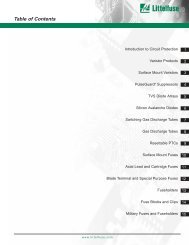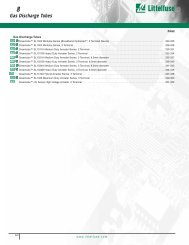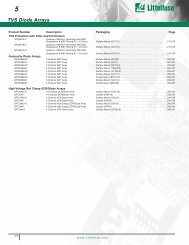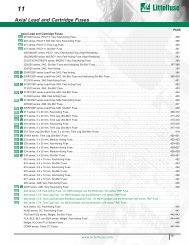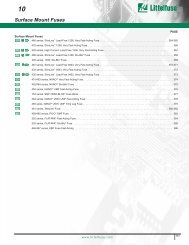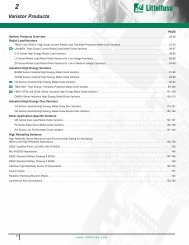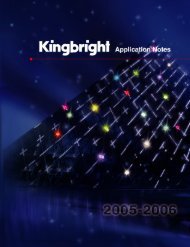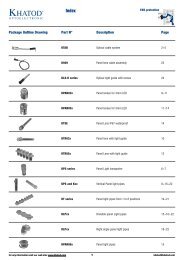ALUMINUM ELECTROLYTIC CAPACITORS
ALUMINUM ELECTROLYTIC CAPACITORS
ALUMINUM ELECTROLYTIC CAPACITORS
You also want an ePaper? Increase the reach of your titles
YUMPU automatically turns print PDFs into web optimized ePapers that Google loves.
PRECAUTIONS AND GUIDELINES<br />
Failure Modes Internal Causes<br />
Short Circuit<br />
Open Circuit<br />
Capacitance<br />
Drop<br />
tanE (ESR)<br />
Increase<br />
Leakage Current<br />
Increase<br />
Open Vent<br />
Short Circuit<br />
Between Electrodes<br />
Dielectrical Break of<br />
Oxide Layer<br />
Dielectrical Break of<br />
Separator<br />
Disconnection of<br />
Terminal Construction<br />
Poor Terminal<br />
Connection<br />
Less Electrolyte<br />
Electrolyte<br />
Vaporization<br />
Anode Foil<br />
Capacitance Drop<br />
Cathode Foil<br />
Capacitance Drop<br />
Deterioration of<br />
Oxide Layer<br />
Corrosion<br />
Internal Pressure Rise<br />
Electrolyte Leakage Poor Sealing<br />
Life of Aluminum Electrolytic Capacitors<br />
The life of aluminum electrolytic capacitors is large ly de pen -<br />
dent on environmental and electrical factors. Environmental factors<br />
in clude tem per a ture, humidity, atmospheric pressure and<br />
vi bra tion. Electrical factors include operating voltage, ripple current<br />
and charge-discharge duty cycles. The fac tor of tem per ature<br />
(ambient temperature and in ter nal heating due to rip ple<br />
current) is the most crit i cal to the life of alu mi num electrolytic<br />
capacitors.<br />
General formula to estimate lifetime:<br />
The lifetime of non-solid aluminum electrolytic capacitors is<br />
gen er al ly expressed by using three elements representing<br />
the effects of ambient tem per a ture, applying voltage and<br />
rip ple current, which is shown by the following equation:<br />
LX=L·KTemp·KVoltage·KRipple<br />
Where : LX =Lifetime of capacitor to be estimated<br />
Lo =Base lifetime of capacitor<br />
KTemp =Ambient temperature accelation term<br />
KVoltage=Voltage accelation term<br />
KRipple =Ripple current accelation term<br />
KTemp (Effects of ambient temperature on life):<br />
Because an aluminum electrolytic capacitor is es sen tial ly an electro<br />
chem i cal component, in creased temperatures ac cel er ate the<br />
chem i cal reaction pro duc ing gas within the capacitor which is<br />
diffused through the end seal, and con se quent ly ac cel er ates a<br />
gradual decrease in capacitance and a grad u al in crease in tanE<br />
and ESR. The fol low ing equation has been ex per i men tal ly found<br />
to ex press the relationship between the tem per a ture ac cel er ation<br />
factor and the deterioration of the ca pac i tor.<br />
LX=LO·KTemp=LO·B<br />
(TO-TX) /10<br />
KTemp=B<br />
(TO-TX) /10<br />
Where : LX =Lifetime (hour) of capacitor to be estimated<br />
Lo =Base lifetime (hour) of capacitor<br />
To =Maximum rated category temperature (C) of capacitor<br />
shown in catalog<br />
TX =Actual ambient temperature (C) of capacitor<br />
B =Temperature accelation factor ( ~ 2)<br />
Electrochemical Reaction<br />
Table1<br />
(7/10)<br />
Mismanaged<br />
Production<br />
Burred Foil/<br />
Metal Particle<br />
Local Deficiency in<br />
Oxide Layer<br />
Mechanical Stress<br />
Poor Connection<br />
Contamination<br />
By Chloride<br />
Poor Sealing<br />
Primary Factors<br />
Mishandled<br />
Application<br />
Mechanical Stress<br />
Excessive<br />
Thermal Stress<br />
Excessive<br />
Operating Voltage<br />
Reverse Voltage<br />
Excessive<br />
Ripple Current<br />
Excessive<br />
Charge-Discharge Duty<br />
Unavoidable Factors<br />
in Normal Service<br />
Deterioration With Time<br />
Chloride Contamination By Assembly Board Cleaning<br />
This equation is similar to Arrhenius’ equation that ex press es a<br />
relationship between chemical reaction rates and tem per a ture,<br />
and called Arrhenius’ rule of aluminum electrolytic ca pac i tors.<br />
The tem per a ture acceleration factor (B) is ap prox i mate ly 2 over<br />
an ambient temperature range (Tx) from 40C to the max i mum<br />
rated category temperature of each ca pac i tor. It means that the<br />
life time is ap prox i mate ly halved with every 10C rise in am bi ent<br />
tem per a ture and can be extended by using the ca pac i tors at<br />
low temperatures. For an ambient tem per a ture range (Tx) of<br />
20C to 40C, the factor B will be close to 2, and the lifetime will<br />
ac tu al ly be extended. How ev er, operating and surrounding condi<br />
tions, especially the op er at ing conditions infl uence am bi ent<br />
tem per a tures mu tu al ly. The am bi ent temperature in this range<br />
will be very change able; there fore, lifetime es ti ma tion un der 40C<br />
should use 40 as Tx.<br />
Kvoltage (Effects of applying voltage to life):<br />
Miniature and large sized aluminum electrolytic capacitors for<br />
popular applications, such as surface mount types, radial lead<br />
types, snap-in types and block types, have little volt age ef -<br />
fect on their life. Other factors like temperature and ripple<br />
current de ter mine the life in comparison with volt age, as long<br />
as the ca pac i tors are used at voltages and tem per a tures with in<br />
the spec i fi ca tions pre scribed in the catalog. Con se quent ly,<br />
Kvoltage=1 is used for these capacitors. 350V and high er screwmount<br />
terminal types of capacitors for cus tom er-use power<br />
elec tron ics applications al low the life time to ex tend by ap ply -<br />
ing low volt age, relating to the characteristics of their alu mi -<br />
num oxide layer. KMH, RWG, RWF, RWE, RWY, RWL and<br />
LXA se ries are applicable to the meth od. For Kvoltage val ues of<br />
these products, please con tact a rep re sen ta tive of Nippon<br />
Chemi-Con.<br />
Kripple (Effects of ripple current to life):<br />
Aluminum electrolytic capacitors have higher tanE than any<br />
oth er types of capacitors; therefore, the ripple current gives<br />
alu mi num electrolytic ca pac i tors higher internal heat. Be sure<br />
to check the rated ripple current which is spec i fi ed in the cat a -<br />
log for assuring the life.<br />
CAT. No. E1001H




